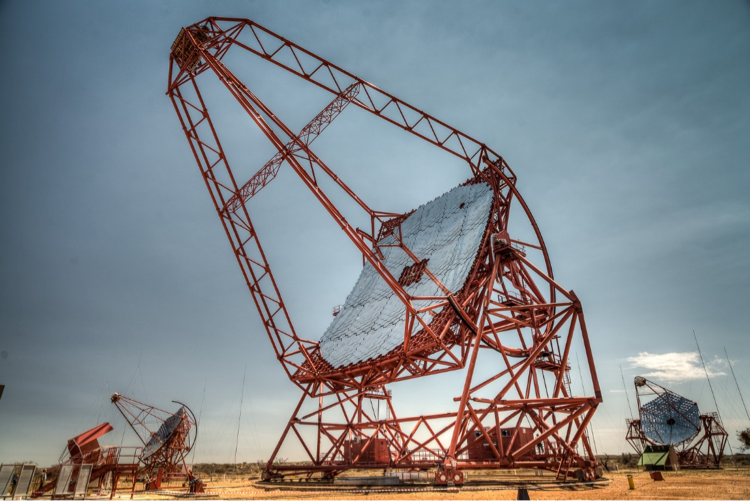
The H.E.S.S. large central telescope with a 614 m² mirror area used in the detection of GRB180720B.
A multinational team of researchers including scientists from the University of Adelaide has shown for the first time that certain kinds of supernova explosions can emit gamma rays bursts of extreme energies that can be detected from the Earth’s surface.
University of Adelaide’s Associate Professor Gavin Rowell is a member of the High Energy Stereoscopic System (H.E.S.S.) team. They have published their findings in Nature which challenge existing knowledge of gamma-ray bursts (GRBs) and their origin.
“Our observation of a gamma-ray burst suggests the accelerated particles creating the gamma-rays still exist or are created a long time after cosmic explosions,” he says.
“After over a decade of looking at many other gamma-ray bursts, H.E.S.S. was able to confirm its first detection of gamma rays from a hypernova at energies never before seen.”Associate Professor Gavin Rowell
“Supernovae represent the dramatic death throes of massive stars, and they can be some of the most energetic and violent events in the universe.
“The team used the H.E.S.S. gamma-ray telescopes in Namibia to reveal the gamma-rays, each of which have an energy more than 100 billion times the energy of optical light.”
Spy satellites started detecting gamma ray bursts coming from outer space in the 1960s, but it wasn’t until the 1990s that new satellites provided valuable data to help unravel the mystery of these bursts of gamma rays.
“Some of these gamma-ray bursts are associated with massive stars ending their lives as ‘hypernovae’ which create intense beams or jets of radiation, concentrating energy into narrow directions. If these jets are pointing towards the Earth, then we can see the gamma-ray burst which typically lasts no more than a minute or two,” says Associate Professor Rowell.
A new gamma-ray burst, named GRB 180720B by scientists, was detected in July 2018. It was a very strong gamma-ray burst and lasted for about 50 seconds, which was a relatively long duration indicating the death of a massive star. Its core collapsed to a rapidly rotating black hole. The surrounding gas formed an accretion disk of diffuse material in orbit around the black hole, which then created jets that were visible from Earth despite the immense distances.
“After over a decade of looking at many other gamma-ray bursts, H.E.S.S. was able to confirm its first detection of gamma rays from a hypernova at energies never before seen,” says Associate Professor Rowell.
“Due to its location the H.E.S.S. telescopes were well placed to search some ten hours after the initial event for a very high-energy afterglow from the burst.
“While the detection of gamma-ray bursts at these high energies had long been anticipated, the discovery many hours after the initial burst came as a great surprise.
“This and other aspects of the H.E.S.S. results present new challenges to theoretical models of particle acceleration in gamma-ray bursts and, indeed, to where we believe cosmic-rays come from.”
From the lessons learned during the detection of the GRB 180720B gamma-ray emission and their updated observational strategy, the H.E.S.S. scientists are in a position to anticipate future high-energy GRB detections which will give them a deeper understanding of this phenomenon.






